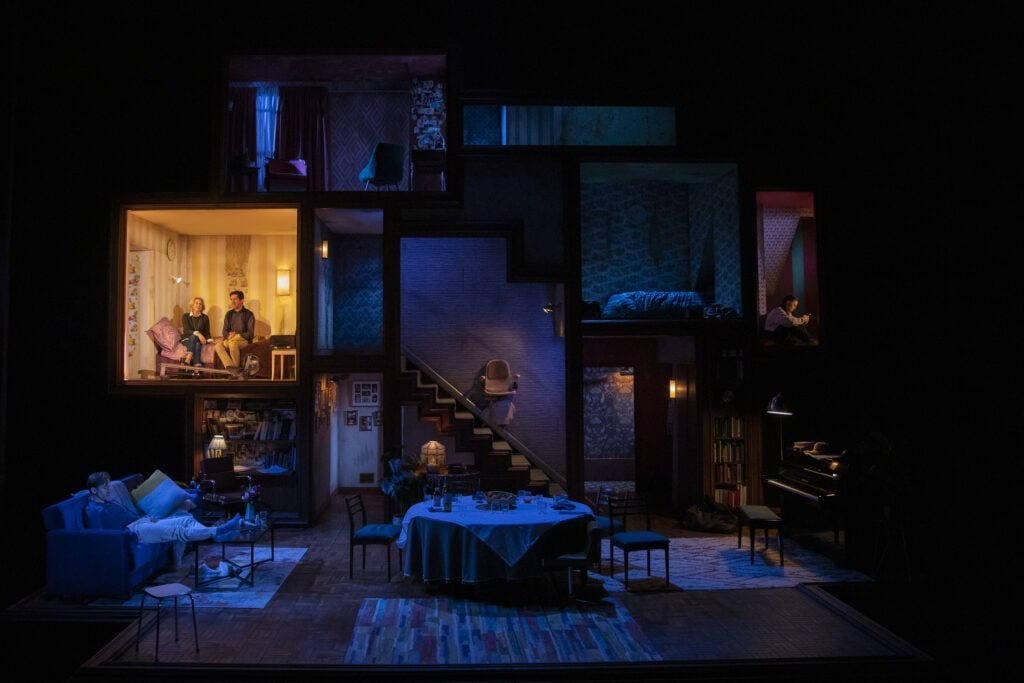The Inheritance of Genius
“We were the IVF Mafia”
Prof Richard Myers

Alexis Zegerman’s latest play looks at the family of an outstandingly successful doctor. The fictional embryologist Professor Richard Myers (Robert Lindsay) is said to have worked with Patrick Steptoe at Bourn Hall in Cambridgeshire, where the first test tube baby was conceived and born. In fact the term test tube is an inaccuracy because Louise Brown was actually conceived in a Petri dish.
Professor Robert Myers has a wall covered in photographs of the babies created by IVF thanks to him. What is missing from this photograph collection is a photograph of his only grandchild, Lily (Nancy Allsop) the lone child of his daughter Dorothea (Lisa Dillon), not because she was conceived by IVF but because she is his blood relative. Lily has a genetic illness, the very rare fever syndrome of the title which causes her temperature to rise with seizures as the result.
The professor is increasingly disabled by Parkinson’s Disease. His third wife, Megan (Alexandra Gilbreath) is caring for him in their unmodernised, peeling wallpaper West Side, New York Brownstone house. His children, Dorothea (Dot) and her husband Nathaniel (Nate) (Bo Poraj), his twin son Tom (Alex Waldmann) and boyfriend Philip Tennyson (Jake Fairbrother) are waiting for Tom’s twin Anthony (Sam Marks) to arrive from California. They have been invited to witness their father getting an award for lifetime achievement. Lily has been trying out the newly installed chair lift.

Tom is an artist but like the photos of Lily, his painting gifts to his father are unseen, stored in the loft. Richard says Tom has always been fiercely independent. This independence might also be impacting on his future with Philip.
It seems that everyone has their own agenda for Richard’s wealth. Tom wants to explore cures for Parkinson’s; Dot wants to conceive another child pre-screened for fever syndrome and money to care for Lily, and Anthony has his own crypto-currency business. Megan wants to make sure that they can continue living in this house.
This is a showcase for Robert Lindsay’s acting the man hampered by Parkinson’s and haunted by the vision of Dot as a little girl. He rages and explodes with frustration at his disability and at the Republican Party and Sarah Palin.
Dot is described as “Dissatisfaction” from childhood to adulthood. Her longing for another child, not like Lily, is sadly overheard. Her husband Nate published some research late and was accused of stealing someone else’s intellectual property and wants a job with Professor Myers’s institute.
Lizzie Clachan had a complicated design brief to construct this house on three floors with views of a few bedrooms so that some conversations can be overheard. The unfortunate result, like the play itself, is overstuffed compartments, cramping the acting and direction.
Maybe Alexis Zegerman had a vision for a series like Succession rather than one, almost three hour, play. Certainly, The Fever Syndrome seems to be full of themes yet to be developed.

Production Notes
The Fever Syndrome
Written by Alexis Zegerman
Directed by Roxana Silbert
Cast
Starring:
Robert Lindsay
Lisa Dillon
Alexandra Gilbreath
Nancy Allsop
Sam Marks
Bo Poraj
Alex Walhmann
Jake Fairbrother
Charlotte Pourret Wythe
Creatives
Director: Roxana Silbert
Designer: Lizzie Clachan
Movement Design: Wayne Parsons
Lighting Designer: Matt Haskins
Sound Designer: Max Pappenheim
Information
Running Time: Two hours 50 minutes with an interval
Booking to April 2022
Theatre
Hampstead Theatre
Eton Avenue
Swiss Cottage
Tube: Swiss Cottage
Reviewed
by Lizzie Loveridge at
Hampstead Theatre
on 4th April 2022

